
Advanced Climate Control System (if so equipped)
The available Advanced Climate Control System (ACCS) keeps the air inside of the vehicle clean, using the automatic air circulation control with an exhaust gas/outside odor detecting sensor and ion control. The Advanced Climate Control system comes with exhaust gas detection/ outside odor sensor. When the automatic air circulation control is activated, the sensor detects odors outside the vehicle, such as pulp or chemicals, and exhaust gas such as gasoline or diesel. When such odors or gas are detected, the display and the system automatically changes from the fresh air mode to the recirculation mode. When the automatic air circulation control mode is on, for the first 5 minutes, the air recirculation mode is selected to prevent dust, dirt and pollen from entering the vehicle and clean the air inside of the vehicle. After 5 minutes, the sensor detects exhaust gas and automatically alternates between the air recirculation mode and fresh air mode.
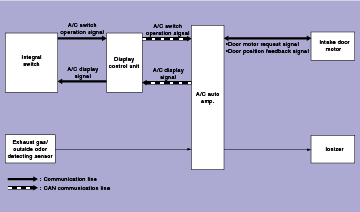
Infiniti InTuition
Infiniti InTuition describes the new Q50’s navigation system equipped with Telematics function. It is an interactive, computerized vehicle control system that allows individual drivers to customize vehicle settings relating to navigation, in-vehicle temperature, driving comfort, driving mode, and engine performance.
The adoption of log-in function allows stored user-touser settings to be called up through the recognition of the last user by the Intelligent Key. The log-in function identifies the driver through the use of the Intelligent Key and calls up driver-specific settings for items such as audio, navigation, seat position and PERSONAL mode settings of the Infiniti Drive Mode Selector.
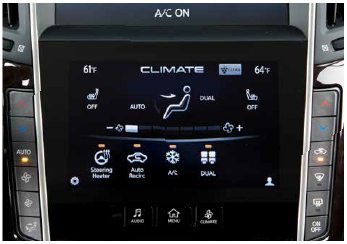
Personalized For You
performance standards in its class is the high degree of available personalization which is made possible with the new fully customizable digital environment. The system works with the vehicle’s advanced Infiniti Intelligent Key fobs to recognize pre-set preferences for a maximum of four Intelligent Keys. They can be registered to memorize settings for three profiled users and one guest. Offering a sense of “my car knows me,” the I-key can recognize not only the driver’s preferred driving seat position and ideal heating and cooling climate settings but also his/her preferred audio, navigation settings, and drive mode. The moment it senses a programmed Infiniti Intelligent Key, it makes sure the Q50 is exactly the way the driver wants it to be. It is not magic; just advanced technology that happens to feel that way.
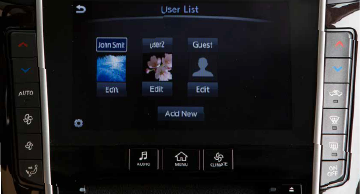
Infiniti Intelligent Cruise Control
The Intelligent Cruise Control (ICC) system is designed to maintain a selected distance from the vehicle ahead within set speeds. When there is a vehicle traveling ahead, the vehicle-to-vehicle distance control mode adjusts the speed to maintain the distance, selected by driver, from a vehicle ahead. The adjusting speed range is up to the set speed.
The Distance Control Assist (DCA) system shares its systems and components with the ICC system. When the Distance Control Assist system is ON, the ICC sensor calculates a distance from a vehicle ahead and a relative speed to transmit the ICC sensor signal to the ADAS control unit via ITS communication. When DCA is activated and there is a vehicle traveling ahead, the vehicle-to-vehicle distance control mode adjusts the speed to maintain the distance. DCA is for low speed following, at speeds that are below minimum set speed for ICC or conventional cruise. Based on the received signal, the ADAS control unit then transmits a control signal to the accelerator pedal actuator via ITS communication and to the electrically-driven intelligent brake unit via CAN communication.
The vehicle-to-vehicle distance control mode uses a sensor located behind the lower grille of the front bumper to detect vehicles traveling ahead. The sensor generally detects the signals returned from the vehicle ahead. If the sensor cannot detect the reflection from the vehicle ahead, the ICC system may not maintain the selected distance. The ICC system is designed to automatically check the sensor’s operation within the limitation of the system.
When the sensor area of the front bumper is covered with dirt or otherwise obstructed, the system will automatically be canceled. If the sensor is covered with ice, heavy rain, small debris or a translucent vinyl bag, the ICC system may not detect them. In these instances, the vehicle-to-vehicle distance control mode may not cancel and may not be able to maintain the selected following distance from the vehicle ahead. Be sure to check and clean the sensor regularly.
RearView Monitor Camera System
The RearView Monitor displays 130 degrees directly behind the vehicle. The audio unit supplies power to the rearview camera when the reverse signal is received from the BCM. The RearView camera transmits images to the audio unit when power is supplied from the audio unit. The audio unit combines a warning message and fixed guidelines when the image is received from the RearView camera and then displays the camera image on the screen.
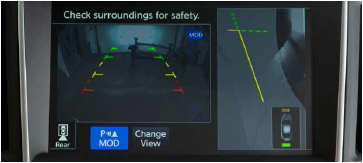
When the selector lever is shifted to the R (Reverse) position, the rearview monitor image is displayed. The vehicle width guide lines and the predicted course lines, that indicate the vehicle route according to the steering angle, are displayed on the rearview monitor display to allow the driver to more easily judge distances between the vehicle and objects and to help the driver back into a parking space.
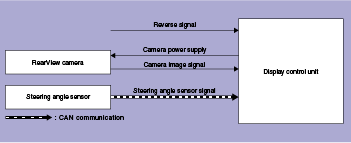
Around View® Monitor With Moving Object Detection
The Around View® Monitor (AVM) system was designed to help enhance visibility when parking. AVM creates and displays views of every side (virtual 360 degrees) of the vehicle, which helps reduce blind spots when parking. The latest version incorporates Moving Object Detection to alert the driver to moving objects around the vehicle.
The system consists of four ultra wide angle cameras:
- One in the rear license plate finisher
- One behind the Infiniti badge in the front grille
- One under each outside mirror.
How it Works
A computer synthesizes the images taken by the four cameras to display a virtual overhead view of the vehicle and any objects that are low and close by the vehicle. When the camera button is pressed, the front view is displayed in any gear shifter position other than R (Reverse) and in D (Drive) at low speeds. When activated, the LCD screen in the center dash displays two views. The right side of the display shows the synthesized overhead view of the vehicle, revealing the position of the vehicle in relation to parking lot lines, the curb, parked cars or other obstacles. The left view shows the view directly behind the vehicle (when the transmission is in R [Reverse]) or in front of the vehicle (when the transmission is in D (Drive) at low speeds).
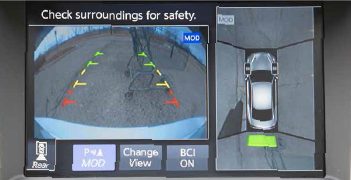
In the front and rear views, green, yellow and red lines are displayed to help judge distances. Separate orange lines are coordinated with steering wheel movement. They bend to indicate the direction the vehicle is moving.
With the transmission in R (Reverse), two views appear on the center display screen. On the left is the camera view to the rear of the vehicle with guide markings that show the path the vehicle will follow. On the right is a composite view from above, showing the position of the vehicle. As you back into the spot, the guide markings bend to show the way the vehicle is being steered. The overhead view helps make it easier to judge your position. It shows how close you are to the curb, parked cars or other obstacles.
When you press the CAMERA button, the overhead view is replaced with a view of the right side of the vehicle. This is especially helpful when parallel parking. When you put the transmission in D (Drive) to pull forward and center the vehicle, the left side of the display shows the view to the front of the vehicle.
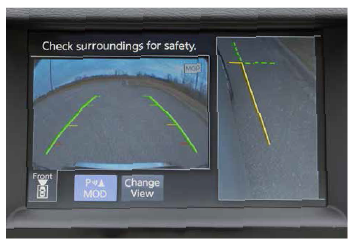
Moving Object Detection (MOD)
The Moving Object Detection (MOD) system informs the driver of any moving objects surrounding the vehicle with images and a chime when driving out of garages, maneuvering in and out of spaces in parking lots and in other such instances.
The MOD system operates in the following conditions when the camera view is displayed:
- When the shift lever is in the P (Park) or N (Neutral) position and the vehicle is stopped, the MOD system detects the moving objects in the bird-eye view. The MOD system will not operate if the outside mirror is moving in or out or if either door is opened.
- When the shift lever is in the D (Drive) position and the vehicle speed is below approximately 5 MPH (8 km/h), the MOD system detects moving objects in the front view or front-wide view.
- When the shift lever is in the R (Reverse) position and the vehicle speed is below approximately 5 MPH (8 km/h), the MOD system detects moving objects in the rear view or rear-wide view. The MOD system will not operate if the trunk lid is open.
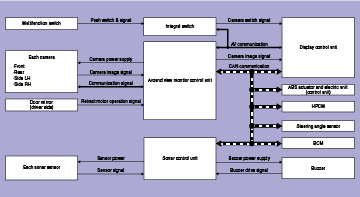
Telematics System
The adoption of the Telematics system allows the provision of information and services in real time.
The Telematics Communication Unit (TCU) is equipped with a cellular terminal that communicates with the information center (Infiniti Connection™ Data Center) via radio waves for receiving Infiniti Connection™ services. In addition to the services received while driving, various kinds of vehicle information can be obtained via Infiniti Connection™ Data Center by using a cell phone or personal computer. The Telematics system interacts with the Infiniti Connection Data Center using GPS and GSM/GPRS technologies. The Telematics Control Unit (TCU) can send messages to and receive commands from the Infiniti Connection Data Center. This allows the Infiniti Connection Data Center to monitor the vehicle and obtain actual position coordinates and automatically detected events as well as initiate certain services from outside the vehicle. In addition, the vehicle operator can initiate services from inside the vehicle.
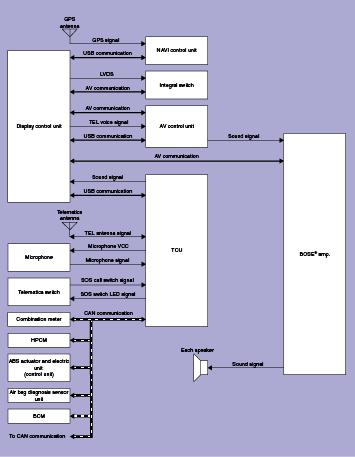
Previous Next
Table of Contents
![]()








